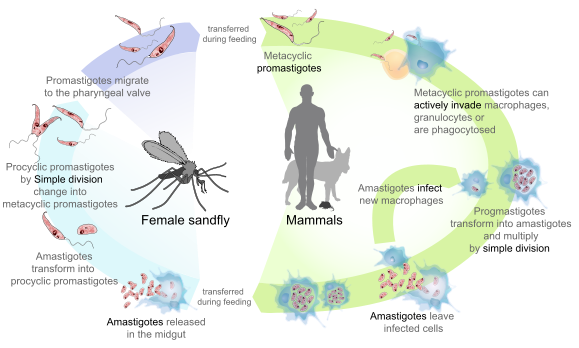| Home Medical Index | First Posted: Oct 03, 2012 Jan 21, 2020 | |
Leishmaniasis/Horses and HumansWhat is leishmaniasis? It is an insect borne (by a female sand fly) parasitic disease which is a microscopic parasite--not a virus--not a bacteria. In the United States leishmaniasis is mostly found in Florida. Globally it is found in areas such as the tropics or subtropics. It is, however, on the rise in North America. In horses, the parasite causes problems to the skin. It can spread throughout the body. Ulcerations on the horse's head, ears, legs and neck are often seen. For an excellent article follow this link: Autochthonous Leishmania siamensis in Horse, Florida, USA  Life Cycle "Leishmania is a genus of Trypanosomatid protozoa, and is the parasite responsible for the disease leishmaniasis. It is spread through sandflies of the genus Phlebotomus in the Old World, and of the genus Lutzomyia in the New World. Their primary hosts are vertebrates; Leishmania commonly infects hyraxes, canids, rodents, and humans. Leishmania currently affects 12 million people in 88 countries. The parasite was named in 1903 after the Scottish pathologist William Boog Leishman. OriginThe origins of Leishmania are unclear. One possible theory proposes an African origin, with migration to the Americas. Another migration from the Americas to the Old World about 15 million years ago, across the Bering Strait land bridge. Another proposes a palearctic origin. Such migrations would entail migration of vector and reservoir or successive adaptations along the way. A more recent migration is that of L. infantum from Mediterranean countries to Latin America (there named L. chagasi), since European colonization of the New World, where the parasites picked up its current New World vectors in their respective ecologies. This is the cause of the epidemics now evident. One recent New World epidemic concerns foxhounds in the USA. ... Pentavalent antimonial compounds such as sodium stibogluconate and meglumine antimoniate are the traditional treatments for leishmaniasis. Among all of the computationally screened compounds, pentamidine, 1,3-dinitroadamantane, acyclovir and analogs of acyclovir had higher binding affinities than the real substrate (guanosine monophosphate). Amino acids of HGPRT that are frequently involved in the binding of these compounds are Lys 66, Asp 74, Arg 77, Asp 81, Val 88, Tyr 182, Arg 192 and Arg 194. It is predicted that patients suffering from both HIV and visceral leishmaniasis (VL) may benefit if they are treated with acyclovir or pentamidine in conjunction with first-line antileishmanial therapies such as miltefosine and AmBisome.Ansari ''et al.'' Resistance to the antimonials is prevalent in some parts of the world, and the most common alternative is amphotericin B...Paromomycin is an inexpensive alternative with fewer side effects than amphotericin that The Institute for OneWorld Health has funded for production as an orphan drug for use in treatment of leishmaniasis, starting in India. New research in the Netherlands on a cancer drug called Miltefosine has shown promising results in treating Leishmaniasis. Miltefosine is the first effective oral treatment for leishmaniasis and is currently undergoing human trials. On its own it has an 88.2% success rate in curing Leishmania but when paired with antimonials the success rate jumps to near 100%. Common adverse effects of the miltefosine treatment are nausea, abdominal discomfort and temporary diminution of ejaculate volume, but few patients discontinue treatment as a result of these adverse effects. Miltefosine is embryotoxic and teratogenic, prohibiting use during pregnancy and, because of its long residence time, requires effective contraception up to at least 5 months after treatment. ..." For More Information: American cutaneous leishmaniasis in horses from endemic areas in the north-central mesoregion of Paraná state, Brazil. |